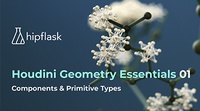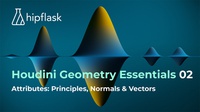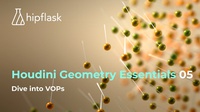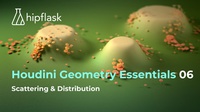Geometry Essentials
Geometry in Houdini is different to other applications and requires a far deeper understanding than most people realise, beginners and 3D professionals alike. VFX, direct modelling, procedural modelling, UVs, scene layout – it all starts here.
6 Tutorials 0:00:00
Tutorials

Geometry Essentials 01: Components & Primitive Types
Geometry in Houdini is different to other applications and requires a far deeper understanding than most people realise, beginners and 3D professionals alike. VFX, direct modelling, procedural modelling, UVs, scene layout – it all starts here.
By the end of this course, you’ll have a deep understanding of:
Houdini’s geometry components – points, vertices, primitives, edges and breakpoints.
How geometry is constructed in Houdini by connecting points.
The importance and power of vertices in controlling connectivity.
The concepts, theories and practical uses of Houdini’s primitive types – polygons, nurbs, beziers, meshes, polysoups and quadratic primitives.
How to easily convert from one primitive type to another – plus when and why you’d want to.

Geometry Essentials 02: Attributes: Principles, Normals & Vectors
Attributes are crucial to Houdini’s greatness. They’re the gin to its tonic, the Robin to its Batman, the velcro to its… other side of velcro. The point is, attributes are what give Houdini its edge, what make it more powerful than any other 3D program. The pure control, flexibility and freedom that you wish other apps provided, attributes are to thank. Because of them, you can see what’s happening with your geometry data and directly manipulate it in ways other applications don’t allow.

Geometry Essentials 03: Attributes, Variables & Parameters
Learn the difference between attributes and variables, understand how to use parameter expressions, and put it to use by learning to create procedural systems.

Geometry Essentials 04: Drive Parameters with Attributes
Master generating, modifying and using attributes to drive SOP parameters. Learn how to work with expressions, and know when to use relative versus absolute paths.

Geometry Essentials 05: Dive into VOPs
Get a head start on VEX by learning how to use VOPs to control attributes, modify geometry and build custom SOPs.

Geometry Essentials 06: Scattering & Distribution
Harness new levels of proceduralism. Dive deep into controlling attributes using noise & random functions, and learn to manipulate attributes using colour correction techniques.
Category: Modeling